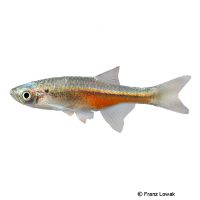Fireline Devario (Devario sondhii)
| Fireline Devario Devario sondhii | |
|---|---|
| Name | Fireline Devario |
| Name Lat. | Devario sondhii |
| Family | Danios |
| Family lat. | Danionidae |
| Order | Carps |
| Order lat. | Cypriniformes |
| Origin | Southeast Asia |
| Habitat | Stagnant water bodies |
| Diet | Carnivore |
| pH | 6.5-7.5 |
| Behavior | Peaceful |
| Keeping | Swarm |
| Care Level | Moderate |
| Reproduction | Egg scatterer |
| Breeding | Difficult |
| Life Span | 4-7 years |
| Protection | No |
| Metric Units | |
| Size | 4-5 cm |
| Temperature | 20-26 °C |
| Hardness | 5-15 °dH |
| Aquarium | 80 l |
| US Units | |
| Size | 1.6"-2" |
| Temperature | 68-79 °F |
| Hardness | 89-267 ppm |
| Aquarium | 20 gal |
Distribution and habitat
The distribution area of the red neon tetra is near Hopong in Shan State in eastern Myanmar. There they live in permanently flooded grassland with shallow, only about 30 cm deep water with dense underwater vegetation.
Maintenance
The aquarium should have very dense planting (hiding and retreat possibilities). A dark substrate, shaded light (floating plants), hardly any current and neutral to slightly alkaline water is ideal
No ammonia, ammonium and nitrite should be detectable, the nitrate value should not exceed 100 mg/l. To ensure the water quality and oxygen content, a filter and heater adapted to the aquarium size is required, as well as lighting for the species-appropriate day-night rhythm of the animals.
Diet
In the wild they feed mainly on insects and insect larvae. The food supply consists of live food, such as cyclops, daphnia, artemia and red mosquito larvae, which are also easily accepted frozen, plus commercially available frozen special food mixtures, supplemented with high-quality, protein-rich dry food (granules, flakes, pellets).
Only as much should be fed as is eaten in a few minutes. A regular and varied diet promotes health and prevents deficiency symptoms.
Behaviour and compatibility
They are very peaceful fish that are well suited for a community tank with other small, peaceful fish. In too small groups they remain shy and are sometimes intraspecies aggressive. At least 5, but better much more animals should be kept together
Basically, only mutually compatible fish species with similar demands on water condition and water temperature should be socialized.
Sex dimorphism
Adult males are somewhat slimmer and intensely red in color, while females are larger and more plump.
Reproduction and breeding
They are free spawners and do not engage in brood care. The male swims around (drifts) the female, which spawns among fine-feathered plants. The larvae hatch after 24-36 hours and swim freely after a few days.
Juveniles must be fed several times a day with special rearing food (dust food). In a community tank breeding is hardly possible, because the spawn is easy prey.
Important
Originally, the Devario sondhii was referred to as Danio sondhii, or Brachydanio sondhii.
The tank should be well covered as they like to jump.
The well-being of the fish should be checked regularly. Temperature should be checked daily, pH, hardness and nitrate levels at least every 14 days. Regular partial water changes are recommended, even if the contaminant level has not yet reached the upper limit. Sudden changes in water quality should be avoided. Newly introduced fish must be accustomed slowly to the water in the aquarium.
Further literature can be found in your pet store.
References
Text: petdata; Image: Franz Lowak
Source: BMELV (1998): Tierschutzgutachten - Haltung von Zierfischen (Süßwasser); ENGELMANN (2005): Zootierhaltung - Tiere in menschlicher Obhut: Fische, Verlag Harri Deutsch
- Gemäß § 21 Abs. 5 Tierschutzgesetz idgF
